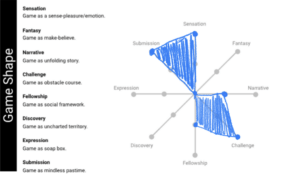Checkpoint 1: Concept Doc
CS247G P1 – Party Game
Game Title: Surviving Stanford
Tag line: WarioWare-style microgames centered around Stanford students’ experiences!
Name of Designers: Noor, Julia Rose, and Tom
Snapshot
Description: A multiplayer co-op game where you and your friends are new students at Stanford! Face a series of “microgames” that last only a few seconds with increasing time crunch and difficulty as you progress through Stanford!
The fun: The microgames are strung together in quick succession with differing control schemes, encouraging frantic action by the player.
Similar Games: Warioware
Format: Hot Seat Minigames
# of players: 2 – 5
Recommended ages: 12 +
Play duration: 10 minutes

Sensation: 2 – frenzy!
Fantasy: 0
Narrative: 1
Challenge: 2
Fellowship: 1
Discovery: 0
Expression: 0
Submission: 2
Brainstormed mechanics (5 per person)
Tom
- Ways/suggestions to turn the score into a drinking game (# of penalties)
- Non video-game minigames (with prompts)
- Are minigames always competitive or always coop? (can they be a mix?)
- Sound activated minigames (where players have to say something into their phone)
- Gyroscope-enabled minigames (like tossing a phone a certain height)
Noor
- Players work together towards a goal (cooperative)
- low skill level/barrier to entry
- High silliness quotient
- Repetition of microgames with increasing difficulty through speed or visual obstacles
- No instructions // player gets better with familiarity and more experienced players are at an advantage
Julia
- Different majors themed microgames
- Form teams for certain microgames based on different criteria (upperclassmen vs lowerclassmen, people with the nearest birthdays, etc.)
- Mario Party “bonus stars” mechanic at the end? Like “biggest loser” type prizes
- “Endless mode”? (don’t end the game while the fun is still high!)
- Competitive tiebreaker round?
————-WarioWare/Surviving Stanford notes—————–
What WarioWare can teach us about Game Design
- Cool article about how warioware breaks/makes design! (specifically the 2003 GBA erosion)
Gameplay
WarioWare essentially challenges players to complete a series of “microgames” that last only a few seconds with increasing time crunch and difficulty over time. Replaying game modes to challenge yourself, play more difficult versions of microgames, and earn a new, better score, is WarioWare’s core mechanic.
The fun
The microgames are strung together in quick succession with differing control schemes, encouraging frantic action by the player.
Rules
On each floor, each player will play 4 random microgames at the floor speed. There will be x microgames total, and each player will play a random 4 from that group. The group can only have 4 mistakes on each floor. If they receive more than 4 mistakes (player 1 fails once, player 2 fails twice, player 3 fails twice, for example) then they fail the level and have to start at the beginning.
Highlights
Cooperative, no skill, multiplayer party game
Our spin?
Surviving Stanford – each microgame is related to the student experience and each level is a class year. As you go through the levels, the microgames go faster as you are meant to be more experienced (i.e. frosh at speed 3 secs while soph at speed 2 sec). Final boss microgame which is something related to graduation
Microgame ideas
- Compost the apple (Aim/shooting)
- Cross the street without getting hit by a bike (Cross Road)
- Plug in the charger before the laptop dies (Key Reflex Test)
- Save the document before the laptop dies (would be funny they have to do ctrl + s) (Key Reflex Test)
- Stanford tree on cheerleader pyramid
- Enroll in classes before Axess crashes (Key Reflex Test)
- Get food in the dining hall without getting hit by freshmen (Cross Road)
- “Hit the word count” (type x keys as fast as possible, but don’t go over)



